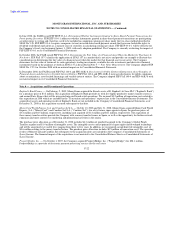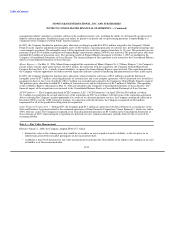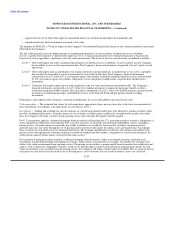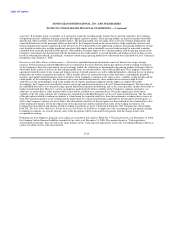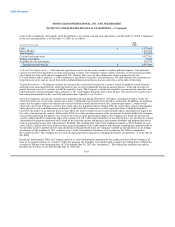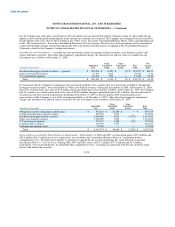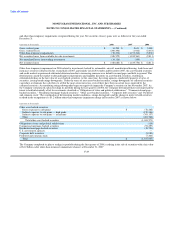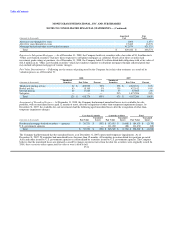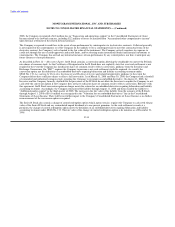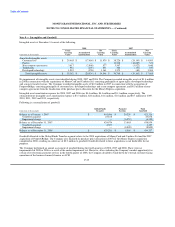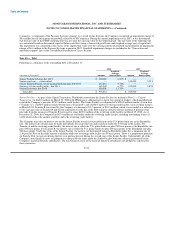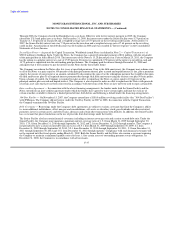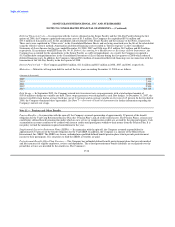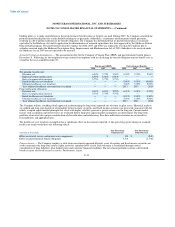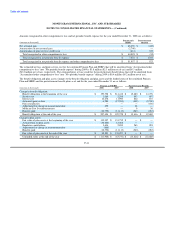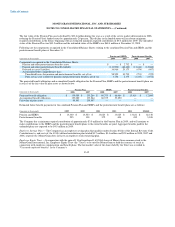MoneyGram 2008 Annual Report Download - page 118
Download and view the complete annual report
Please find page 118 of the 2008 MoneyGram annual report below. You can navigate through the pages in the report by either clicking on the pages listed below, or by using the keyword search tool below to find specific information within the annual report.
Table of Contents
MONEYGRAM INTERNATIONAL, INC. AND SUBSIDIARIES
NOTES TO CONSOLIDATED FINANCIAL STATEMENTS — (Continued)
Note 7 — Derivative Financial Instruments
The Company historically used interest rate swaps to hedge the variability of cash flows from its floating rate debt, as well as its floating
rate commission payments to financial institution customers of the Payment Systems segment, primarily relating to the official check
product. In connection with its restructuring of the official check business in the first quarter of 2008, the Company terminated, or is in
the process of terminating, certain of its financial institution customer relationships. The termination of the relationships led the Company
to discontinue hedge accounting treatment in the first quarter of 2008 as the forecasted transaction would no longer occur. The
commission swaps were terminated in the second quarter of 2008, resulting in a $27.7 million loss being recognized in "Investment
commissions expense" in the Consolidated Statements of (Loss) Income. Additionally, as described in Note 10 — Debt, the Company's
Senior Facility was deemed extinguished as a result of the modifications made to the Senior Facility in connection with the Capital
Transaction. As a result, the Company discontinued hedge accounting treatment of its debt swap in the first quarter of 2008 and
terminated the swap in the second quarter of 2008. As a result of the debt swap termination, the Company recognized a $2.0 million loss
in "Interest expense" in the Consolidated Statements of (Loss) Income.
The notional amount of the Company's interest rate swap agreements totaled $1.4 billion at December 31, 2007, with an average fixed
pay rate of 4.3 percent and an average variable receive rate of 4.2 percent. The variable rate portion of the swaps was generally based on
the effective federal funds rate or LIBOR. As the swap payments were settled, the net difference between the fixed amount the Company
pays and the variable amount the Company received was reflected in the Consolidated Statements of (Loss) Income in "Investment
commissions expense" and "Interest expense," depending upon the item being hedged.
Cash flow hedges use derivatives to offset the variability of expected future cash flows. Variability can arise in floating rate assets and
liabilities, from changes in interest rates or currency exchange rates or from certain types of forecasted transactions. The Company enters
into foreign currency forward contracts of 12 months to hedge forecasted foreign currency money transfer transactions. The Company
designates these currency forwards as cash flow hedges. If the forecasted transaction underlying the hedge is no longer probable of
occurring, any gain or loss recorded in equity is reclassified into earnings. The notional amount of outstanding cash flow hedges as of
December 31, 2008 was $18.1 million, all maturing in 2009.
The Company also uses forward contracts to hedge exposures to foreign currency exchange risk arising from its assets and liabilities
denominated in foreign currencies. While these contracts economically hedge foreign currency risk, they are not designated as hedges for
accounting purposes. The effect of changes in foreign exchange rates on the foreign-denominated receivables and payables recorded in
the Consolidated Statements of (Loss) Income, net of the effect of the related forward contracts, was a $5.5 million loss, a $1.5 million
loss and a $0.2 million gain in 2008, 2007 and 2006, respectively. As of December 31, 2008, the Company had $98.4 million of
outstanding notional amounts relating to its forward contracts.
As of December 31, 2008, the Company reflects the following fair values of derivative forward contract instruments in its Consolidated
Balance Sheets:
Balance Sheet Asset Liability Net
(Amounts in thousands) Location Fair Value Fair Value Fair Value
Forward contracts Other Assets $ 134,389 $ (135,588) $ (1,199)
Forward contracts Receivables, Net 17,897 (15,444) $ 2,453
Total $ 152,286 $ (151,032) $ 1,254
As of December 31, 2008, the Company recognized $0.8 million of unrealized losses on its forward contracts in "Accumulated other
comprehensive income" in the Consolidated Balance Sheets. For the year ending December 31,
F-32


